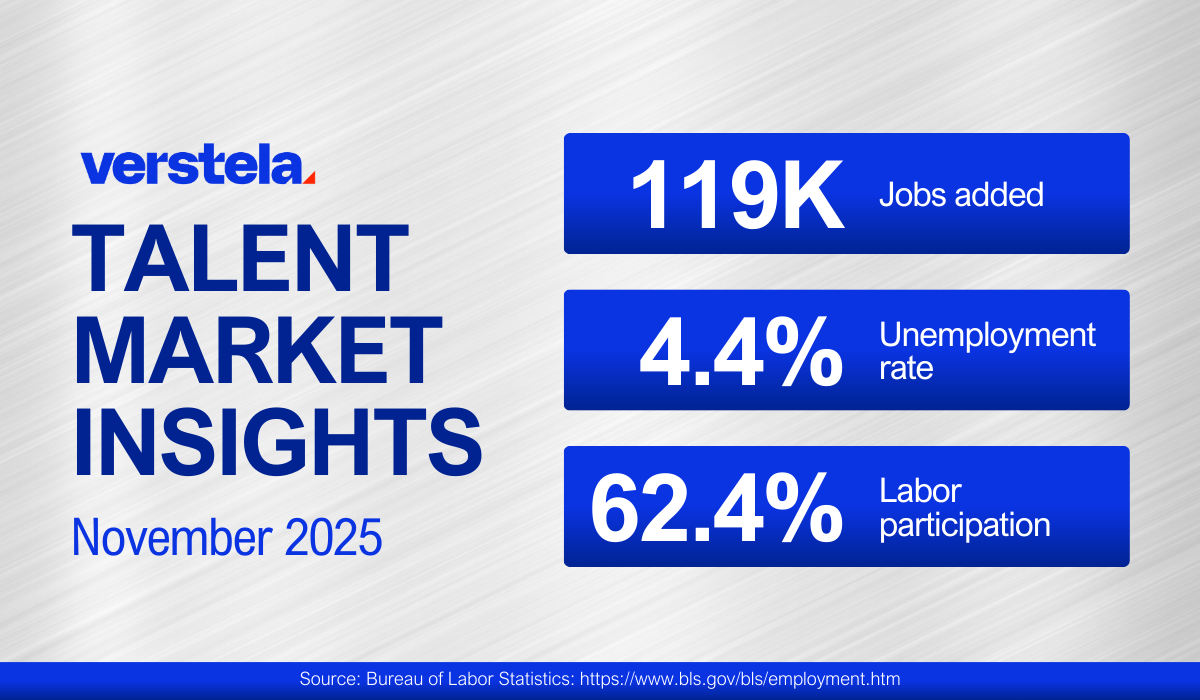What the September 2025 jobs report means for employers
The delayed September jobs report points to a labor market that’s still working—but clearly slowing. Job gains were modest, hiring was concentrated in just a few sectors, and several indicators show a gradual cooling compared to earlier in the recovery.
For HR and business leaders, this means hiring is still very possible, but results may feel more uneven across roles, locations, and industries. It’s a moment to be intentional about where you invest your hiring efforts and how you build flexibility into your workforce.
Key takeaways from the September 2025 jobs report
- 119,000 jobs were added in September. Total nonfarm employment has shown little change since April.
- Unemployment held at 4.4%, with 7.6 million people unemployed. This is higher than a year ago (4.1%).
- Labor force participation held at 62.4%, and the employment-population ratio at 59.7%. Both are down 0.4 points over the year.
- Average hourly earnings rose 0.2% in September and 3.8% over the past year. For production and nonsupervisory workers, wages grew 0.3%.
- Revisions lowered July and August job gains by a combined 33,000, pointing to slightly weaker momentum than initially reported.
Overall, the market is still functioning—but with slower growth and less broad-based hiring.
Job growth by sector
Job gains were narrowly concentrated in:
- Healthcare: +43,000
- Ambulatory health care services: +23,000
- Hospitals: +16,000
- Food services and drinking places: +37,000
- Social assistance: +14,000
- Individual and family services: +20,000
Losses occurred in:
- Transportation and warehousing: –25,000
- Warehousing and storage: –11,000
- Couriers and messengers: –7,000
- Federal government: –3,000 (and down 97,000 since January)
Most other major industries—including construction, manufacturing, retail trade, information, financial activities, and professional and business services—showed little or no change.
For light industrial and logistics employers:
The decline in transportation and warehousing may mean more candidates entering the market from those roles in some regions, even as overall hiring demand cools.
Unemployment and labor force participation
The unemployment rate remained at 4.4%, with 7.6 million people unemployed in September. Both the rate and the number of unemployed are higher than a year earlier.
A few details beneath the surface:
- Long-term unemployed (27+ weeks): 8 million (23.6% of all unemployed)
- People not in the labor force who currently want a job: 9 million
- Marginally attached to the labor force: 7 million
- Discouraged workers: 557,000
The labor force participation rate (62.4%) and employment-population ratio (59.7%) changed little over the month but are down compared to last year, pointing to softer overall engagement even as the population grows.
Wage growth
Wage growth continued at a moderate pace:
- Average hourly earnings: up 0.2% in September; up 3.8% over the past year
- Production and nonsupervisory workers: up 0.3% in September
This level of wage movement suggests that while pay remains elevated compared to pre-pandemic norms, the intense wage pressure of earlier periods has eased somewhat—giving employers a bit more room to plan.
What employers can do now
Here are a few practical ways employers can respond to these conditions:
1. Prioritize essential roles
With job growth modest and flat since spring, focus your hiring efforts on roles that directly support operations, safety, customer needs, or revenue. Clear prioritization helps ensure limited hiring capacity is used where it matters most.
2. Broaden your candidate pool
Long-term unemployment remains elevated, and more people say they want a job even if they’re not actively searching. Consider talent with transferable skills from adjacent industries—especially candidates moving out of logistics or warehousing into production, assembly, or other light industrial roles.
3. Watch for talent shifts in logistics-heavy markets
Transportation and warehousing lost 25,000 jobs in September. In markets with a strong logistics presence, you may see more applicants from these backgrounds. Align your screening and onboarding to make it easier for these workers to move into your open roles.
4. Revisit pay and expectations
With wage growth moderating, employers can use this moment to review compensation, make sure rates are in line with current market data, and clarify expectations around overtime, incentives, and career paths.
5. Use staffing to stay agile
When demand is uncertain, temporary and project-based staffing can help maintain productivity without long-term commitments. This approach gives you the ability to scale up or down as conditions change—especially helpful in light industrial, logistics, and support roles.
Employer outlook
Looking ahead, the labor market is likely to remain uneven:
- Growth will continue to lean on healthcare and social assistance.
- Transportation, warehousing, and the federal sector may face ongoing headwinds.
- Talent availability may improve in some pockets while staying tight in others.
For HR and business leaders, the priority is less about reacting to every data point and more about staying ready: clear priorities, flexible plans, and the right mix of full-time and temporary talent.
Put insights into action
At Verstela, we don’t just track the numbers—we help employers translate them into real workforce decisions.
We support organizations with:
- Local labor market insights
- Staffing strategies for light industrial and logistics roles
- Flexible staffing solutions to manage changing demand
→ Explore Employer Resources for tools and insights
→ Connect with our team to talk through what this report could mean for your hiring and workforce strategy




